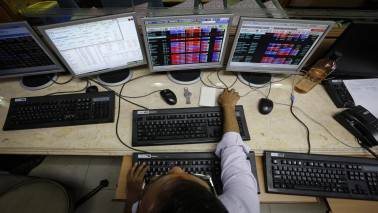What is making D-Street nervous? Top 6 factors driving bulls away from markets
Weak rupee, crude rally and FII selling, among others, seen as the reasons behind the Street's fall.

The Nifty slipped below its crucial support level of 9800 in trade on Wednesday weighed down by losses in Adani Ports, Sun Pharma, RIL, ICICI Bank, and SBI.
The S&P BSE Sensex lost over 300 points in intraday trade. The index has lot nearly 1400 points from its record high of 32686.
The S&P BSE Midcap index slipped 0.5 percent while the S&P BSE Smallcap index was down by 0.6 percent.
We have collated a list of top five factors which might be weighing on sentiments:
Weakness in rupee:
The Federal Reserve needs to continue gradual rate hikes despite broad uncertainty about the path of inflation, Fed Chair Janet Yellen said on Tuesday. History suggests that a rate hike pushes up Dollar and weakens the rupee.
Traders of short-term interest-rate futures see about a 76 percent chance of December rate hike but are betting on only one rate hike next year, said a Reuters report.
This is something which we are already witnessing on D-Street. The currency weakened for the fifth straight session to hit a fresh 6-month low on Wednesday. At 10 am, the rupee is trading at 65.54 a dollar, down 0.14% from its Tuesday’s close of 65.45
A weakening currency is something which foreign investors do not like much. “Foreign investors typically like to invest in a market whose fundamentals are strong and there is an expectation of currency appreciation over the medium term,” Ajay Bodke, CEO & Chief Portfolio Manager (PMS) at Prabhudas Lilladher Pvt. Ltd told Moneycontrol.
“Why? Because, when FIIs take the money back in dollar terms they earn a higher return,” he said. The reverse also holds true. “A falling currency creates an alarm among foreign investors who are already invested in the market,” said Bodke.
Indian Army strikes hideouts of Naga militants on Myanmar border
The Indian Army struck hideouts of Naga militants along the Myanmar border early on Wednesday.
NSCN-K cadres are believed to have suffered heavy casualties as a result of the counter-insurgency operation that took place at around 4.45 am. The Indian Army said none of its personnel were hurt in the operation, contradicting reports that have suggested otherwise.
Crude Oil Price near 26-month high:
One big reason for the current slide in the market is a steady rise in crude oil prices. The component makes for most of our import bill and has a huge bearing on our current account deficit.
As long as crude oil prices were trading below $50, everything was hunky dory but the trend is likely to continue. Brent oil is hovering near a 26-month high after US data showed an unexpected drop in crude stocks.
Crude price is an important factor to watch out for. Any surprise in price uptick in crude oil shall be detrimental for Indian markets because it has a negative correlation with equity markets.
“Rising crude oil prices have an inverse correlation with Indian equity markets. And, with crude boiling at 2-year high and is expected to breach $60/bbl soon – it does not project a pretty picture,” said Bodke.
“If you remember, govt increased excise duty when crude was trading at lower levels but if the levels breach a certain level, the government might have reduce excise duty which will lead to a strain in fiscal deficit situation as import bill will go up and excise duty will come down, ” he said.
Sharp selling by foreign investors:
The liquidity argument which was driving asset prices higher has slowed down, on the fears of fiscal slippages and heightened geopolitical tensions between the US and North Korea.
The foreign portfolio investors (FPIs) have already started taking out money from equity and debt market and flows from domestic investors have also slowed down.
Since August, foreign institutional investors (FIIs) sold nearly $2.4 billion in equities, while in last three sessions, they sold nearly $210 million in debt markets, said a report.
The 10-year bond yield was at 6.672%, compared to its previous close of 6.669%. Bond yields and prices move in opposite directions.
Earnings may not cheer investors in Sep quarter:
Most analysts were expecting a revival of earnings from September quarter but demonetisation and the implementations of the goods and services tax (GST) may have pushed the target by few more quarters.
Which bring to our next point i.e. high valuations. Investors pumped money into equity markets driving valuations at levels which may not be sustainable for long unless earnings catch up.
“In the past one month, valuations had run up ahead of fundamentals and liquidity flows were high. But, local and global events such as crude price hike, weak rupee, and news of fiscal stimulus package have triggered a profit-taking among investors,” Krishna Kumar Karwa, MD, Emkay Global Financial Services told CNBC-TV18 in an interview.
Going forward, chances of another top are less likely, Karwa said. “Earnings may not be supportive in this quarter and many analysts have downgraded them for FY18 based on overall growth,” he told the channel.
In fact, this kind of a deceleration was probably not priced in and said that one must wait for corporates to declare Q2 results. “That will be the right time for the market to take a reality check and temporary setbacks, if any, could be visible in these numbers, said Karwa.
Technical Factors:
The Nifty slipped below its crucial support level of 9800 in trade today which acted as a support in recent past. The index is now trading below its crucial short-term moving averages such as 50-days exponential moving average (DEMA), 20-DEMA, 10-DEMA, and 5-DEMA.
Highest option interest in current series is placed at 10000 call, while it got shifted from 9700 to 9800 put option which does not auger well for bulls.
Due good amount of build-up in 10000 call option of October series, the highest concentration is now at 10000 call for next series, which was at 10200 earlier.
The Put Call Ratio has decreased from 1.57 (last week) to 1.11 on back of fresh shorting in call options and unwinding by put writers, which doesn’t bode well for the Bulls.
“FIIs continued their selling pressure in both cash market and index futures segment for yet another session. With Tuesday's selling of Rs1916 crores, FIIs cumulatively curbed liquidity to the tune of Rs. 16238 crores in September series so far,” Jay Purohit, Technical & Derivatives Analyst at Centrum Broking told Moneycontrol.
“At current junctures, FIIs are net long in index futures by only 3226 contracts (Long Short Ratio is at 50.50%). This is their lowest long positions in index futures after November 2016,” he said.
Considering the above data, Purohit added that the September series may expire around 9800 mark and we may see further selling pressure in the next series. Thus, traders are advised to buy Nifty 9800 put options of October series.















